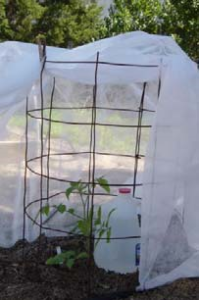Frosts and freezes mark the transition of our gardening seasons here in central Texas. There is a lot of confusion when it comes to frosts and freezes, and what practical things we can do to protect our plants.
Here in central Texas we live between the northern zones where there is a REAL winter season each year and the sub tropics where freezing weather rarely if ever arrives. As a result, our landscapes include many plants that are marginally hardy and need some help to make it through an unusually cold winter. Warm days followed by a really cold snap are a recipe for serious plant injury.

Freeze damage often results in blackened plant tissue.
Container Plants Most Susceptible to Cold
Especially susceptible are plants in containers. Plant roots have little ability to acclimate or develop cold tolerance. While the ground stays well above freezing on a bitter cold night, the soil in a container gets almost as cold as the air temperature. A container plant’s above ground parts may survive a cold snap while the roots may suffer injury. Cold injury to roots of plants in exposed containers is a common occurrence and often is not evident until the following season when warmer temperatures begin to place increased demands on the plant.
How and Why to Cover Your Plants From Cold
Covering plants is the best way to protect them from the cold. There are some thick types of plant cover fabric available in local garden centers and by mail order that can provide a few degrees of protection on a cold night. Blankets also work well but are heavier and may require some supports to avoid crushing tender bedding plants. If you lay a sheet of plastic over the plant cover fabric or blankets it works even better for holding in heat. Plastic will burn the leaves it touches on a cold night, so use a frame of some sort. Always remove the covers during the day to allow the sun to warm the soil and then cover them again at night.
The heat we are trying to contain is in the soil. Therefore the covers should go over the plants and to the ground, rather than be wrapped around the plant and tied around the trunk. Those “landscape lollipops” don’t get much, if any, protection.
Supplemental Heat to Consider

Water filled milk jugs can provide latent heat to protect plants.
Even though we are trying to capture the heat from the ground, you can use supplemental heat to help. Two examples of this are a string of outdoor Christmas lights and water-filled milk jugs. These can be placed under the covers to give added heat. Just take the obvious precautions to avoid fire hazards and electric shorts. Also take care not to allow a hot light bulb to contact and damage plant tissues such as the trunk or branches. Test your lights to make sure they emit hit – some of the newer types do not so they wouldn’t be effective as frost protection. Use lights beneath a cover to protect valuable but marginally hardy plants like a Satsuma orange tree or a kumquat bush. They can also make the difference for an in-ground bougainvillea on a really cold night.
The second item is a water-filled milk jug. Water absorbs heat during the day and will radiate it slowly during the night. Place the jug as close as you can to the plant without touching – you don’t want the leaves to freeze on the condensation that will occur.
Both lights and jugs should be paired with some sort of blanket or covering.
Keep Plants Hydrated and Soil Moist
When a freeze is forecast, give plants a good watering day or so in advance. Drought stressed plants are more susceptible to cold injury. The moist soil is also a good “heat sink”, absorbing heat during the day and radiating it out slowly on a cold night. Combined with a cover it can make a small but important difference. Take care not to overwater or create a waterlogged soil condition. Soil dries out much more slowly in winter. Soggy soil excludes oxygen from the roots, often resulting in root loss and attack by root rotting fungi.
Can Sprinklers Protect Plants from Frost?
Commercial producers sometimes use sprinkler systems for frost protection when trees and berries are blooming. However, just going outside and sprinkling the foliage and branches of plants prior to a freeze does NOT help protect them. In fact it can do more harm than good because the water droplets can freeze on the leaves and stems. Using sprinklers to protect plants is a balance between temperature, duration, and dew point. Careful calculation must be made to determine when and for how long to use water to prevent damage. Michigan State University Extension has a great article on how to do this correctly.
Mulch Provides Protection Too
Use leaves to mulch perennial plants. A thick blanket of leaves can help protect marginal perennials such as ginger and firebush. You can then add the leaves to your compost once the cold period ends. Use shredded leaves to help keep them from blowing away, or weigh them down with compost or branches. Regular mulch works well also, just be sure not to bury your plants. Thick mulches can prevent water from reaching the soil, so you may need to rake it back temporarily to irrigate if soil becomes dry.
Will freezing temperatures be a concern for wildflower rosettes?
Most of our wildflowers sprout in the fall and spend their winters as rosettes, which are plants with shortened stems that grow very close to the ground. This strategy allows them to survive and even thrive through the worst cold that Central Texas can throw at them, or even snow, should we happen to get any. Depending on your soil type and the amount of natural rainfall and number of sunny days, you might need to water as much as once a month on clay soils, or a couple of times a month on really well-drained soil, rocky soils. But if we have a cool, cloudy winter, with even one or two rainfall events, you may not need to water at all. If you do water your wildflower areas, be sure to give them a deep, thorough soaking.
Why do some plants die in freezing weather?
There are actually a few ways that freeze damage occurs on plants, but most commonly it happens when the frozen water in the plant thaws out. Just like ice cubes in your glass, the frozen water cracks as it thaws. In a plant, that same thawing action damages cell walls and cracks open stems and leaves, killing the damaged area. Some plants contain more water than others, especially in their leaves. Many plants also retain high amounts of water in their fleshy stems, so those may freeze too. Plants have different strategies for dealing with cold. Some die completely, leaving the next generation to carrying on in their seeds. Others only lose their tender leaves and perhaps any tender new stem-growth, while other die all the way back to the ground, but have hardy root systems, allowing them to emerge after the harsh cold weather has passed.
Cold injury symptoms on Loquats or other subtropical trees and shrubs
Sometimes cold injury is not readily apparent until the plant starts to flower or actively grow again. If only a few limbs are wilting or starting to die, inspect them for bark damage. Texas AgriLife Extension fruit specialist Jim Kamas tells us that these types of symptoms are almost always result from cold injury. Plants like loquats can be injured even if they are in a protected location. Limit the possibility of cold damage by keeping the plants well-watered, but not saturated, over the winter. Trees and other woody plants can repair themselves, but go ahead and keep the plants in as good of health as possible by removing dead wood once the danger of frost has passed.
Additional Resources
Weather Strategies for the Austin Area
Plant Problems and Maintenance
Protecting Landscapes and Horticultural Crops from Frosts and Freezes

